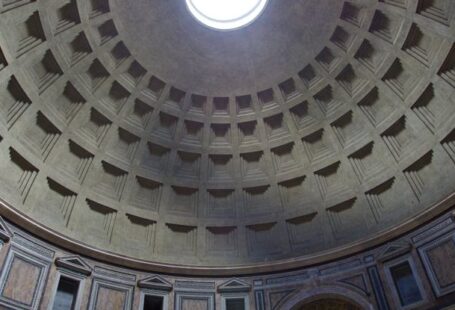The Arch of Constantine stands as a monumental symbol of ancient triumphs and victories in the heart of Rome. Built to commemorate Emperor Constantine’s victory in battle, this iconic structure holds significant historical and cultural importance. From its architectural design to the intricate reliefs that adorn its facade, the Arch of Constantine serves as a testament to the power and prestige of the Roman Empire.
A Triumphal Arch of Unprecedented Scale
The Arch of Constantine, situated near the Colosseum in Rome, is a triumphal arch of unprecedented scale and grandeur. Constructed in 315 AD, it stands at an impressive height of over 21 meters, with three arched passageways framed by intricately carved Corinthian columns. The arch is adorned with richly detailed reliefs depicting scenes from various battles and triumphs, showcasing the military prowess of Emperor Constantine.
Symbol of Victory and Power
Triumphal arches were a common feature in ancient Rome, serving as symbols of victory and power for conquering generals and emperors. The Arch of Constantine, however, holds a special significance as it marked the end of the civil wars that had plagued the Roman Empire for decades. Constantine’s victory over his rival Maxentius at the Battle of Milvian Bridge in 312 AD solidified his claim to the throne and ushered in a new era of stability and prosperity for the empire.
A Blend of Architectural Styles
One of the most striking aspects of the Arch of Constantine is its eclectic architectural style, which combines elements from earlier Roman monuments. The arch incorporates spolia, or recycled architectural fragments, from earlier imperial buildings, including reliefs from the reigns of Trajan, Hadrian, and Marcus Aurelius. This blending of styles and motifs serves as a visual representation of Constantine’s claim to legitimacy and continuity with Rome’s imperial past.
The Iconic Frieze
The iconic frieze that adorns the Arch of Constantine is a masterpiece of Roman artistry, showcasing intricate details and exquisite craftsmanship. The frieze depicts scenes from various battles and military campaigns, including the Siege of Verona and the Battle of the Milvian Bridge. These reliefs not only celebrate Constantine’s military victories but also serve as a propaganda tool to glorify his reign and assert his authority as emperor.
Cultural and Historical Significance
Beyond its architectural and artistic splendor, the Arch of Constantine holds immense cultural and historical significance for Rome and the wider world. As a tangible reminder of the power and prestige of the Roman Empire, the arch continues to attract visitors from around the globe who come to marvel at its beauty and learn about its rich history. The arch also serves as a poignant reminder of the enduring legacy of the Roman Empire and its impact on Western civilization.
Legacy of the Arch
The Arch of Constantine stands as a lasting testament to the triumphs and achievements of the Roman Empire, a tangible reminder of the power and prestige of ancient Rome. Its architectural splendor, richly detailed reliefs, and historical significance make it a must-see attraction for visitors to Rome. As a symbol of victory and power, the arch continues to inspire awe and admiration, serving as a link to the past and a window into the grandeur of Roman civilization.





